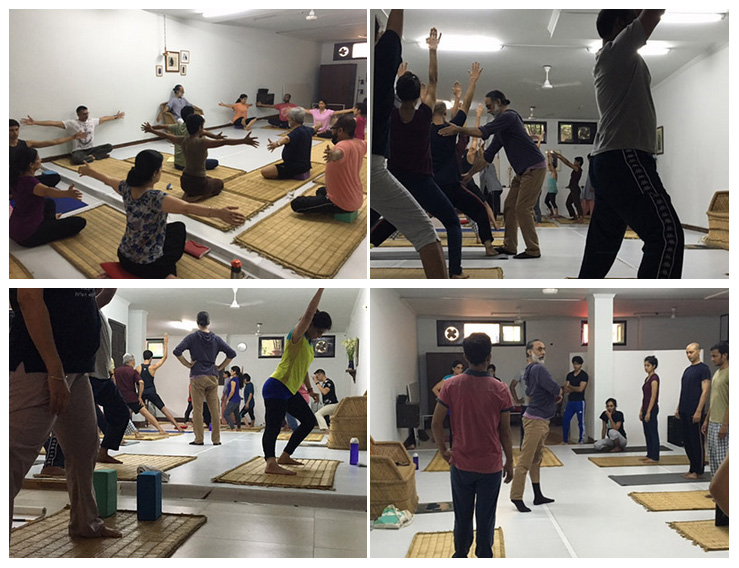|
|
|
PRACTICE
> BARPS Responses to BARPS | Videos Related to BARPS
|
 |
BARPS®: A method devised by Navtej Johar to practice asana more effectively. Bracing: Just as pranayama is described as “mindful breathing”, we define asana as “mindful contact with the floor”. Our first objective is to brace one end of the body firmly against the floor, offering it sthirata or anchorage so it can be effectively elasticised by being stretched in the opposite direction. Aligning: The pull in the opposite direction, however, requires alignment of the joints in order for the stretch to be safe and effective. For this the major joints that are involved in the construction of the asana need to be strung together and the vertebrae to be stacked one atop the other with some measure of precision and alignment. Poising: The articulation of a stretch finally requires a determined moment of poise, a still “look before you leap” moment. It is exactly here that the mind and the breath may be gently ushered into the asana, making the practice more attentive, attuned, absorptive, spacious, and reposeful. Stretching: The body anchored, aligned and autonomously calibrated, and the breath and mind reflexively poised, the cohesive unit comprising of body, breath and mind is ready to commandingly stretch and establish the breathing-body in a safe, fulsome and pleasurable asana. The aim of the BARPS® method is to ensure safety, promote efficacy of the asana, and to offer the body/mind promised experience of sukha and sthira. And, most of all, make the practitioner the master of her/his practice! |
Why BARPS? As a long-time practitioner and teacher of yoga, another thing that I would like to add is that when working with the body, we are looking at – (1) the biological body, that is a cohesive unit comprising the various material of the body, i.e. bones, muscles, tendons, organs etc. which for lack of a better word we could call the ‘internal’ body (2) the ‘external’ or the social body, that we present to the world, this is contingent upon how we choose to position ourselves to both see and be seen by the world, and (3) the mind, that receiving/reflecting entity that is ceaselessly negotiating between this inside and outsideness of the body.The BARPS method is to self-constructively negotiate this triad of the internal-body, external-body, and the mind. In truth, it is not presenting anything new, so it might not be for those already entrenched in a deep yoga practice. But it might prove beneficial for not only new entrants but also those who are trying to understand and appreciate yoga beyond the pale of a variety of historical influxes, namely, Modernity, that is categorical and works within the Cartesian frame of mind-over-body; the various religious doctrines that are categorially dismissive of both matter and the body, and the New-Age that cloaks this deeply elemental practice with mushy metaphors of sweet-nothings. All of these working in their own manner to detract from or dilute the autonomy of the body as an entity that has an innate-intelligence, sensitivity, as well as intentionality of its own. As embodied practitioners, our primary axiomatic truths need to be that (a) the body is ‘enough’, i.e. it is all that I need to become yogically enlightened and (b) I, the practitioner, am ‘good enough’. Today, within the ‘domesticated’ version of yoga that we teach and practice, I feel that it is this ‘good-enoughness’ that is at a premium. Therefore, I find it imperative to explore an approach that offers not only skill but also includes a means to effectively negotiate such historical “self-diminishing” traps in order to arrive at the promise of Yoga.So, how do I, in 2019—given the constraints of Modernity, body-dissing religious doctrine, and New Age—arrive at this mental-clearance through my yoga practice from where I can make considered choices? And how can I earn the licence to arrive at and own my own sense of ‘good-enoughness’, as well as hone and gain confidence in my innate sense of rightness in making choices with calm and clarity?BARPS is an attempt to offer both skill and confidence in this autonomous sense of rightness: in other words, the ability to decipher or intuit from the inside what feels ‘just-right’, trust and honour it, and then act on it. BARPS, a self-regulatory practice that aims at shaping asana with an innate intelligence from the inside, making the practitioner the master of his or her own practice, and simultaneously lay bold claim on his/her bodily experience, while both positioning squarely-within and keeping-at-bay the impinging constraints of the external, sociohistorical world. |
![]()